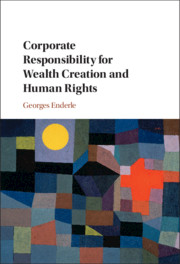Book contents
- Reviews
- Corporate Responsibility for Wealth Creation and Human Rights
- Corporate Responsibility for Wealth Creation and Human Rights
- Copyright page
- Dedication
- Contents
- Figures, Tables and Boxes
- Preface
- Acknowledgments
- 1 Introduction and Overview
- 2 The Context of Globalization, Sustainability and Financialization
- Part I Wealth Creation
- 3 Semantics and the Wealth of Nations
- 4 Wealth Includes Natural, Economic, Human and Social Capital
- 5 Wealth Is a Combination of Private and Public Wealth
- 6 Wealth Creation Is about Producing and Distributing Wealth
- 7 Creating Wealth Involves Material and Spiritual Aspects
- 8 Creating Sustainable Wealth in Terms of Human Capabilities
- 9 Creating Means Making Something New and Better
- 10 Wealth Creation Needs Self-Regarding and Other-Regarding Motivations
- Part II Human Rights as Public Goods in Wealth Creation
- Part III Implications of Wealth Creation and Human Rights for Corporate Responsibility
- Bibliography
- Index of Names
- Index of Subjects
4 - Wealth Includes Natural, Economic, Human and Social Capital
from Part I - Wealth Creation
Published online by Cambridge University Press: 11 January 2021
- Reviews
- Corporate Responsibility for Wealth Creation and Human Rights
- Corporate Responsibility for Wealth Creation and Human Rights
- Copyright page
- Dedication
- Contents
- Figures, Tables and Boxes
- Preface
- Acknowledgments
- 1 Introduction and Overview
- 2 The Context of Globalization, Sustainability and Financialization
- Part I Wealth Creation
- 3 Semantics and the Wealth of Nations
- 4 Wealth Includes Natural, Economic, Human and Social Capital
- 5 Wealth Is a Combination of Private and Public Wealth
- 6 Wealth Creation Is about Producing and Distributing Wealth
- 7 Creating Wealth Involves Material and Spiritual Aspects
- 8 Creating Sustainable Wealth in Terms of Human Capabilities
- 9 Creating Means Making Something New and Better
- 10 Wealth Creation Needs Self-Regarding and Other-Regarding Motivations
- Part II Human Rights as Public Goods in Wealth Creation
- Part III Implications of Wealth Creation and Human Rights for Corporate Responsibility
- Bibliography
- Index of Names
- Index of Subjects
Summary
The wealth of a society is defined as the total amount of economically relevant private and public assets including natural, economic, human and social capital. In line with the OECD well-being framework, these four types of capital are necessary for the sustainability of well-being over time. Natural capital comprises nonrenewable and conditionally renewable natural assets and natural liabilities, land and ecosystems. Two sets of questions are briefly discussed: how natural capital can be valued in monetary terms and to whom the property rights of natural assets and liabilities should be allocated. Economic capital, consisting of physical and financial capital, is far less complicated to evaluate than natural capital. According to UNECE, OECD and Eurostat, “the observed market prices for produced and financial capital are fair reflections of their well-being effects.” The concept of human capital adopted in this book goes beyond the stock of economically productive human capabilities (G. Becker) and means healthy and educated people, while social capital – in Robert Putnam’s sense – refers to “connections among individuals – social networks and the norm of reciprocity and trust worthiness that arise from them.”
- Type
- Chapter
- Information
- Publisher: Cambridge University PressPrint publication year: 2021

